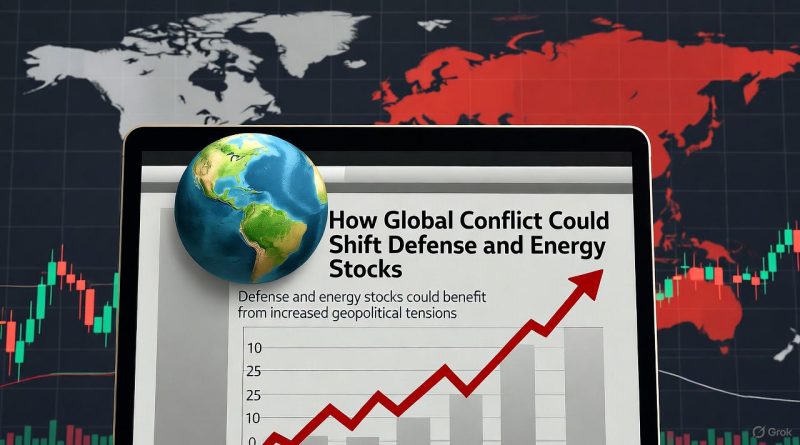How Global Conflict Could Shift Defense and Energy Stocks
In an increasingly volatile world, global conflict has far-reaching consequences, not just for geopolitics, but also for the stock market. Two sectors that consistently react to international tensions are defense and energy. When instability arises, nations boost military spending and seek to secure energy supplies, often triggering rapid shifts in these markets.
In this article, we’ll explore how geopolitical unrest influences defense and energy stocks, what investors should watch for, and how to strategically position portfolios during turbulent times.
1. The Defense Sector: Rising Demand Amid Uncertainty
Whenever geopolitical conflict escalates, the defense industry tends to gain immediate investor attention. This includes companies specializing in aerospace, weapons manufacturing, cybersecurity, and logistics. Governments typically respond to instability by increasing defense budgets, modernizing equipment, and reinforcing strategic alliances.
In recent years, we’ve seen this play out multiple times. From the Russia-Ukraine war to rising tensions in the Middle East and Asia, defense contractors such as Lockheed Martin (LMT), Raytheon Technologies (RTX), Northrop Grumman (NOC), and General Dynamics (GD) have seen increased order volumes and stock momentum.
Defense stocks often provide a hedge against global instability. Unlike consumer discretionary or tech companies, their revenue is directly tied to government contracts that are less sensitive to economic downturns. When nations feel threatened, defense spending becomes a priority regardless of economic conditions.
However, investors must also consider ethical investing concerns. Many ESG-focused funds avoid defense-related equities due to their link to weapons production. Still, for traditional investors, the defense sector’s resilience and government-backed demand can make it a valuable part of a diversified portfolio.
2. The Energy Sector: The Power of Geopolitics
Energy markets are equally reactive to conflict. Wars and trade disruptions can affect oil supply chains, natural gas exports, and shipping routes, directly impacting commodity prices. When geopolitical tension escalates, crude oil and natural gas prices typically rise due to supply fears, even before any actual production shortfall occurs.
For example, during conflicts involving major oil-producing nations, global crude benchmarks such as Brent and WTI often experience sharp upward movements. This benefits energy giants like ExxonMobil (XOM), Chevron (CVX), and BP (BP), along with smaller upstream producers focused on exploration and drilling.
On the flip side, energy importers may suffer higher input costs and inflationary pressures, which can dampen consumer spending and slow economic growth. Meanwhile, renewable energy stocks sometimes benefit indirectly, as nations accelerate investments in domestic energy independence to reduce reliance on volatile regions.
As the world moves toward cleaner energy, the intersection of geopolitics and energy transition becomes increasingly complex. For example, conflicts that disrupt oil supply chains may temporarily boost fossil fuel prices, but they also reinforce the urgency of investing in renewable technologies and alternative energy sources.
3. The Investor Perspective: How to Navigate Market Volatility
For investors, global conflict presents both risk and opportunity. The key lies in understanding how markets respond to uncertainty.
Historically, when tensions rise, defense and energy stocks outperform broader indices, while consumer, tech, and travel sectors often lag. Investors seeking short-term gains may look toward companies with strong government contracts or energy exposure. Meanwhile, long-term investors should maintain a balanced portfolio, ensuring that gains in these sectors offset potential losses elsewhere.
Diversification and timing are crucial. It’s often wise to gradually increase exposure to defense and energy during early signs of geopolitical escalation, rather than chasing rallies after markets have already priced in risk. Exchange-Traded Funds (ETFs) like ITA (iShares U.S. Aerospace & Defense ETF) or XLE (Energy Select Sector SPDR Fund) offer convenient exposure to these sectors without requiring individual stock selection.
Investors should also monitor currency fluctuations, as the U.S. dollar tends to strengthen during crises, impacting multinational profits. Similarly, commodity price trends, interest rates, and supply chain disruptions can influence both sectors’ performance.
4. Long-Term Outlook: Resilience and Realignment
Looking ahead, the relationship between global conflict, defense, and energy markets is likely to persist. Nations are entering a new era of strategic competition, emphasizing national security, energy independence, and technological superiority.
Defense companies are expanding into space, cybersecurity, and AI-driven warfare systems, positioning themselves for long-term relevance. Simultaneously, energy firms are diversifying into renewables, hydrogen, and nuclear technologies, anticipating a gradual global transition away from fossil fuels.
The future may bring a world where geopolitical and economic power are increasingly defined by control of energy resources and technological defense capabilities. For investors, staying informed and adaptable will be key to capturing opportunities while managing risk.
Conclusion
Global conflicts have always shaped markets, but in today’s interconnected economy, the effects are faster and more profound than ever. As tensions rise, defense and energy stocks often emerge as the clear winners amid uncertainty. While no investment is immune to volatility, understanding how these sectors react to geopolitical shifts can help investors make more strategic, informed decisions.
